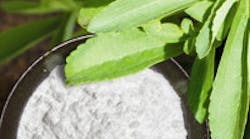Few new ingredients have stirred as much interest as the various extracts of the Paraguayan stevia plant. As we go to press, Cargill Inc. and Whole Earth Sweetener Co. (a subsidiary of Merisant Co.) were awaiting FDA non-objection to separate petitions to call their stevia-based sweeteners generally recognized as safe (GRAS).
Also breathlessly awaiting word are the world’s two biggest beverage makers: PepsiCo allied with Whole Earth and Coca-Cola Co. behind Cargill. Both reportedly have diet colas all ready to roll with the new, apparently “natural,” sweetener. And that’s the real key -- being able to call a non-nutritive sweetener “natural” -- which appears probable with this ingredient.
A small handful of companies already have stevia-sweetened products, mostly soft drinks, on the market, but they get around the lack of FDA approval by labeling them “dietary supplements.”
Photo: PURECIRCLE
And there appears to be no shortage of stevia-based sweeteners available in the U.S., even with the limited applications. Several manufacturers or distributors already have ramped up in expectation of an explosion in demand in 2009. Back in August, Blue California (www.bluecal-ingredients.com), Rancho Santa Margarita, Calif., announced a GRAS self-affirmation for its 99 percent pure rebaudioside, which is sold under the Good & Sweet brand (Blue California also has a 97 percent product).
“Blue California was extremely confident from the very beginning that a product of this level of purity would easily meet the safety requirements for GRAS self-affirmation and the level of scientific data necessary to meet FDA’s required criteria for safety,” says Executive Vice President Cecilia McCollum.
PureCircle Inc. (www.purecircle.com), Kuala Lumpur, Malaysia, is the supplier behind the PepsiCo-Whole Earth petition. Stevia sweeteners also are being marketed by Wisdom Natural Brands, Gilbert, Ariz., and Cumberland Packing Corp., Brooklyn, N.Y.
Even though stevia is being used in dietary supplements, it still needs FDA approval -- at least a non-objection to a petition – to be used as a food additive for conventional foods. “Otherwise the formulated food is [considered] adulterated and subject to FDA enforcement actions,” Robert McQuate, CEO and founder of GRAS Associates, Bend, Ore., said in a presentation at the October Supply Side West show.
Of the various glycosides derived from the stevia plant, most interest (and development) is focusing on stevioside and rebaudioside A, both about 200–300 times sweeter than sucrose, heat stable, pH stable and non-fermentable. Of the two, rebaudioside garners the most interest.
Stevia has been used by indigenous people of Paraguay for 500 years and as a food sweetener in Japan since the 1970s, according to McQuate. He also noted the World Health Organization’s Joint Expert Committee on Food Additives (JECFA) issued a safety determination for steviol glycosides in late June of this year.
The botanical sweetener not only was held back by a slow move from supplement status to food ingredient, it also was the victim of nascent technology. When first launched a decade ago, it wasn’t being purified sufficiently to remove a lingering bitterness.
“The key reason the stevia of 1999 is different from that of today is that stevia of 1999 was a straight extract from the stevia plant, containing all the molecules including the ones with a bitter aftertaste,” says Peter Milsted, sales and marketing director for PureCircle Inc. (www.purecircle.com), Kuala Lumpur, Malaysia. “The stevia of 2008/2009 is Reb A, the sweetest tasting molecule in the plant.”
